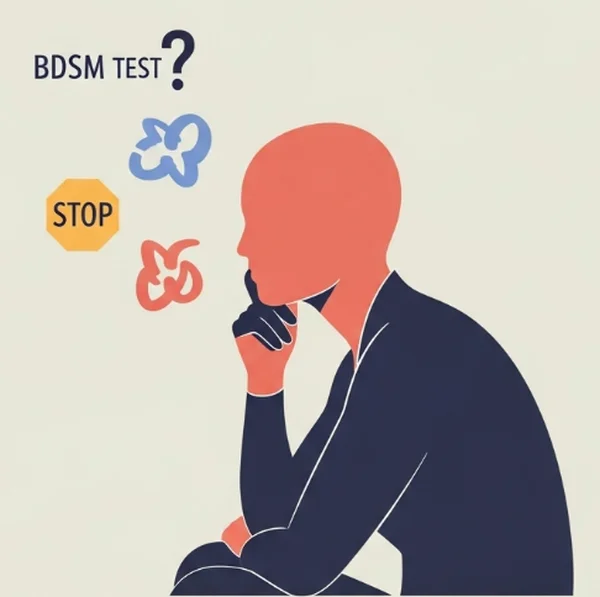Setting Healthy BDSM Boundaries: Using Test Insights
Healthy BDSM Boundaries: How Test Insights Can Help You Define Yours
Engaging in BDSM, like any intimate or intense activity, thrives on a foundation of trust, respect, and clear understanding. Central to this foundation are BDSM boundaries. How to set BDSM boundaries effectively is a question crucial for anyone exploring this realm, ensuring experiences are both pleasurable and safe. This article explores why clearly defined sexual limits are non-negotiable for safe BDSM, how to understand different types of boundaries, the art of consent communication, and significantly, how insights from a BDSM test can serve as a valuable tool in this personal and interpersonal process. Ready to learn how a BDSM test can illuminate your personal limits?
Why Boundaries are Non-Negotiable in Safe BDSM Practices
Before diving into how to set boundaries, it’s vital to understand why they are absolutely fundamental to any safe BDSM dynamic. Well-defined BDSM boundaries are not about restriction; they are about empowerment and mutual care.
The Foundation of Trust and Respect in BDSM Dynamics
Trust is the bedrock of any BDSM interaction, especially those involving power exchange or intense sensations. When individuals clearly communicate their personal limits and know those limits will be respected, a profound sense of trust can flourish. Respecting boundaries is a tangible demonstration of care and consideration for your partner(s), underpinning the entire dynamic. Without this, the very fabric of the interaction frays.

Ensuring Emotional and Physical Safety for All Participants
Clear BDSM boundaries are the primary safeguards for both emotional safety and physical safety. They define the "play area," outlining what is acceptable and, just as importantly, what is off-limits. Knowing these lines exist and will be honored allows participants to relax, explore, and engage more fully and authentically within the agreed-upon parameters, minimizing the risk of unintended harm, distress, or trauma.
How Clear Boundaries Prevent Misunderstandings and Harm
Ambiguity is the enemy of safe BDSM. When sexual limits are unclear or unstated, the potential for misunderstandings, accidental boundary crossings, and resultant harm (emotional or physical) increases dramatically. Explicitly defined BDSM boundaries reduce this ambiguity, ensuring all parties are on the same page and can navigate their interactions with confidence and clarity. This proactive approach is a cornerstone of BDSM ethics.
Understanding Your "Limits": How a BDSM Test Can Offer Clarity
While introspection is key, tools like a BDSM test can provide a structured way to begin thinking about your sexual limits and kink boundaries. Can a BDSM test help with boundaries? Yes, it can be a valuable starting point.
Reflecting on "No-Go" Areas Highlighted by BDSM Test Questions
Many BDSM tests, including the one at bdsmtest.online, include questions or scenarios that touch upon various activities, sensations, or power dynamics that might represent potential BDSM test limits for you. As you respond, you might find yourself having strong "no" reactions to certain prompts. These reactions are valuable data points, highlighting your inherent "no-go" zones or areas where you feel significant discomfort.

Identifying Potential Discomforts and Sexual Limits
Beyond clear "no's," a BDSM test can help you identify activities or dynamics that make you feel hesitant, anxious, or simply uninterested. These might not be hard limits immediately, but they are crucial indicators of potential sexual limits or areas requiring much more thought, discussion, and caution before any consideration of exploration. Recognizing these early helps in setting boundaries more effectively.
Using Test Results as a Personal Inventory for Boundary Awareness
Think of your BDSM test insights regarding limits as a preliminary personal inventory. It’s not a definitive, unchangeable list, but rather a snapshot of your current feelings and comfort levels. This inventory can serve as a fantastic catalyst for deeper self-awareness about your own personal limits and what you need to feel safe and respected.
Types of Boundaries in BDSM: Hard, Soft, and Everything In-Between
BDSM boundaries are not always black and white. Understanding the different types can help in their nuanced articulation and negotiation.
Defining Hard Limits: Your Absolute No's
Hard limits are non-negotiable. These are activities, words, or scenarios that are strictly off-limits under any circumstances. They represent your absolute "no's" and must be unequivocally respected by all parties. Identifying your hard limits is a critical first step in ensuring your safety and well-being.
Understanding Soft Limits: Areas for Caution or Negotiation
Soft limits are more nuanced. These might be things you're hesitant about, willing to try only under specific conditions (e.g., with a trusted partner, slowly, with certain precautions), or things you might enjoy up to a certain point but not beyond. Soft limits require careful consent communication and are often areas where negotiating limits is key.

Recognizing Evolving Boundaries and the Need for Flexibility
It's important to understand that BDSM boundaries can be fluid and may change over time with experience, new knowledge, or shifts in personal comfort. What was once a soft limit might become a hard limit, or vice-versa. This highlights the need for ongoing self-awareness and regular check-ins, rather than assuming boundaries set once are set forever.
The Art of Consent Communication: Voicing Your Boundaries Clearly
Knowing your BDSM boundaries is only half the battle; effectively communicating them is equally, if not more, important. This is where consent communication comes into play.
Assertive vs. Aggressive Communication of Needs and Limits
Communicating your personal limits assertively means stating them clearly, confidently, and respectfully, without being apologetic or demanding. This is different from aggressive communication (which can be hostile or accusatory) or passive communication (where limits are unstated or unclear). Assertiveness empowers both you and your partner(s).
Practical Tips for Effective Consent Communication
-
Be Specific: Instead of saying "I don't like pain," try "I am not comfortable with heavy impact play, but light sensation play might be okay to discuss."
-
Use "I" Statements: "I feel uncomfortable when..." is more effective than "You make me uncomfortable when..."
-
Discuss Before Play: Negotiate BDSM boundaries and sexual limits before engaging in any activity.
-
Establish Safewords: Agree on clear safewords (e.g., "red" to stop, "yellow" to slow down/check-in) that will be immediately honored.
-
Affirmative Consent: Ensure consent is enthusiastic, ongoing, and can be withdrawn at any time. "No means no," and "maybe means no."

Active Listening: Understanding and Respecting Partner's Boundaries
Consent communication is a two-way street. It’s not just about voicing your BDSM boundaries but also about actively listening to, understanding, and unequivocally respecting the personal limits of your partner(s). This fosters mutual respect in BDSM.
Using Your BDSM Test Insights as a Starting Point for Boundary Discussions
The insights gained from a BDSM test regarding your potential sexual limits and discomforts can be a powerful, non-confrontational way to initiate conversations about BDSM boundaries.
Sharing Your Reflections from the BDSM Test with a Trusted Partner
If you have a partner you trust, you might choose to share some of your general reflections spurred by the BDSM test insights. For example, "I took this online test, and it made me realize I'm definitely not comfortable with X, but I might be curious about Y under certain conditions. What are your thoughts?"
How Test Insights Can Facilitate Difficult Conversations About Sexual Limits
Sometimes, broaching the topic of sexual limits can feel awkward. Referring to a neutral tool like a BDSM test can depersonalize the initial discussion, making it easier to talk about sensitive topics. It provides a shared reference point for negotiating limits.
Building a Shared Understanding of Mutual Comfort Zones
Ultimately, the goal is to build a shared understanding of everyone's comfort zones and BDSM boundaries. Using test insights as a conversation starter can help you and your partner(s) map out these mutual areas of comfort and exploration, leading to more fulfilling and safe BDSM experiences.

Navigating Boundary Negotiations and Re-Negotiations
Setting BDSM boundaries is not a one-time event but an ongoing process integral to any healthy BDSM dynamic or relationship communication. It requires continuous self-awareness, open dialogue, and mutual respect.
Boundaries are Not Static: The Importance of Ongoing Dialogue
As you gain more experience, or as your life circumstances change, your personal limits and desires may evolve. This is natural. Therefore, ongoing dialogue about BDSM boundaries and regular check-ins are essential to ensure everyone remains comfortable, respected, and safe.
Tips for Re-Negotiating Boundaries as Experiences Evolve
- Schedule regular check-ins to discuss comfort levels and any shifting sexual limits.
- Be honest if a previous soft limit now feels like a hard limit, or if you're curious about something that was previously off the table (and your partner is open to discussing it).
- Always prioritize enthusiasm and comfort over pushing boundaries for the sake of "experience."
Empower Your Journey: Understand Your Limits with a BDSM Test
A tool like the BDSM test at bdsmtest.online can be an excellent first step in your journey toward better understanding your own potential BDSM boundaries and sexual limits. It empowers you with self-knowledge, which is the foundation for setting healthy boundaries and engaging in fulfilling, safe BDSM.
Frequently Asked Questions About BDSM Boundaries and Test Insights
Let's address some common questions people have:
What if I'm unsure about my boundaries even after a test?
What if my BDSM boundaries change or I'm still unsure? That's perfectly okay. A BDSM test provides initial insights. If you're unsure, it's best to err on the side of caution and treat potential areas of uncertainty as "no's" or "not yet's" until you have more clarity through further reflection, research, or very slow, carefully negotiated exploration with a trusted partner. Your comfort and emotional safety are paramount.
How do I say 'no' or enforce a boundary during a BDSM scene?
How to enforce boundaries in BDSM? This is where safewords are critical. Clearly establish them beforehand. If a boundary is approached or crossed, use your safeword immediately and expect all activity to stop or adjust accordingly. You also have the right to simply say "no" or "stop" directly. Effective consent communication includes the expectation that these directives will be honored without question or coercion.
What if my partner doesn't respect my stated sexual limits?
If a partner consistently disregards or pushes against your clearly stated sexual limits or BDSM boundaries, this is a serious red flag. It indicates a lack of respect and is not conducive to safe BDSM. In such situations, it's crucial to prioritize your safety and well-being, which may involve ending the scene, the interaction, or even the relationship if the behavior persists. Your personal limits are valid.
Can my BDSM boundaries change over time?
Yes, absolutely. As mentioned, BDSM boundaries are often fluid. Experiences, new knowledge, emotional states, and relationship dynamics can all influence your comfort levels and what you're open to. Regular self-reflection and open relationship communication are key to navigating these changes respectfully.
How can a BDSM test help if I'm new to setting boundaries?
If you're new to BDSM or even just new to consciously setting boundaries in intimate contexts, a BDSM test can be a gentle introduction. The questions in a BDSM test for limits can expose you to concepts and scenarios you haven't considered, prompting you to think, "Hmm, how do I feel about that?" This initial reflection, sparked by the BDSM Test on bdsmtest.online, is a valuable first step towards articulating your needs.